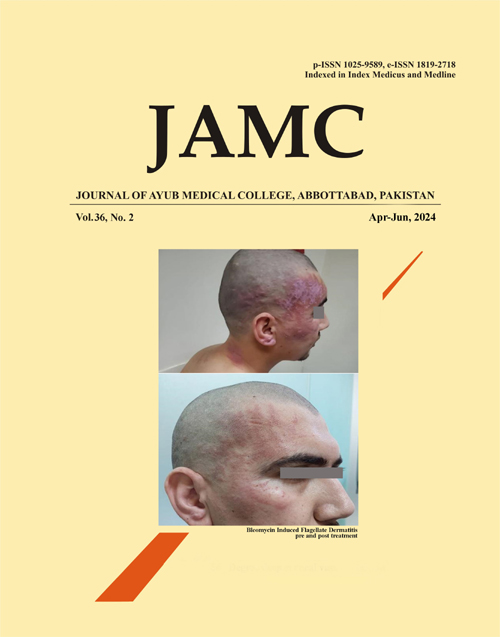BLEOMYCIN INDUCED FLAGELLATE DERMATITIS IN A PATIENT WITH NON-SEMINOMA GERM CELL TUMOUR WITH BILATERAL UNDESCENDED TESTES
Keywords:
Flagellate Dermatitis, Bleomycin, Non-Seminoma Germ Cell Tumor, Undescended TestesAbstract
Flagellate Dermatitis (FD) is a rare cutaneous manifestation of bleomycin toxicity caused by the deficiency of bleomycin hydrolase enzyme in the skin. It typically presents as erythematous patches or papules with linear, multiple flagellate structures. In this article, we report the case of FD in a 21-year-old male patient with non-seminoma germ cell tumour presenting with abdominal pain and bilateral undescended testes since birth. The patient was started on the BEP (Bleomycin, Etoposide and Cisplatin) protocol as per institutional guidelines. On the 17th day of the first cycle, the patient developed multiple whiplash skin lesions over his back, shoulders and front right frontotemporal area with intense itching. A diagnosis of FD was made clinically. Bleomycin was stopped and he was switched to etoposide and cisplatin-based chemotherapy for the remaining three cycles. The rashes were treated with topical steroids (Beclomethasone), Systemic steroids (Prednisolone) and antihistamines (Cetrzine) according to recommended protocol. The patient responded very well to the above-mentioned treatment with the rashes completely disappearing within a span of 14 days. This case highlights the need for vigilance during chemotherapy as it can cause a wide range of skin reactions. FD is a condition with multiple potential causes and mechanisms underlying cutaneous manifestations. Early recognition and prompt treatment can help prevent long-term complications and improve patients' quality of life.
References
Diao DY, Goodall J. Bleomycin-induced-flagellate dermatitis. CMAJ 2012;184(11):1280.
Nayak N, Friedmann PS, Healy E. Clinicopathological cases: case 2. (Bleomycin-induced flagellate dermatosis). Clin Exp Dermatol J 2003;28(1):105-6.
Changal KH, Raina H, Changal QH, Raina M. Bleomycin-induced flagellate erythema: a rare and unique drug rash. West Indian Med J 2014;63(7):807-9.
Ridolo E, Montagni M, Bonzano L, Incorvaia C, Canonica GW. Bilastine: new insight into antihistamine treatment. Clin Mol Allergy 2015;13(1):1-6.
Yamamoto T. Bleomycin and the skin. Br J Dermatol 2006;155(5):869-75.
Netchiporouk E, Pehr K, Ben-Shoshan M, Billick RC, Sasseville D, Singer M. Pustular flagellate dermatitis after consumption of shiitake mushrooms. JAAD Case Rep 2015;1(3):117-9.
Kamata Y, Yamamoto M, Kawakami F, Tsuboi R, Takeda A, Ishihara K, et al. Bleomycin hydrolase is regulated biphasically in a differentiation-and cytokine-dependent manner: relevance to atopic dermatitis. J Biol Chem 2011;286(10):8204-12.
Ozyigit LP, Aktas EC, Senbas ZA, Ozturk AB, Ozturk E, Ergonul MO, et al. The role of atopy in the pathogenesis of bleomycin pulmonary toxicity. Respir Med 2019;155:1-5.
Sibaud V, Fricain JC, Baran R, Robert C. Anomalies pigmentaires induites par les traitements anticancéreux. Première partie: les chimiothérapies. Ann Dermatol Venereol 2013;140(3):183-96.
Masson Regnault M, Gadaud N, Boulinguez S, Tournier E, Lamant L, Gladieff L, et al. Chemotherapy-related reticulate hyperpigmentation: a case series and review of the literature. Dermatology 2015;231(4):312-8.
Krause K, Spohr A, Zuberbier T, Church MK, Maurer M. Up-dosing with bilastine results in improved effectiveness in cold contact urticaria. Allergy 2013;68(7):921-8.
Dalgard FJ, Svensson Ã…, Halvorsen JA, Gieler U, Schut C, Tomas-Aragones L, et al. Itch and mental health in dermatological patients across Europe: a cross-sectional study in 13 countries. J Invest Dermatol 2020;140(3):568-73.
Downloads
Published
How to Cite
Issue
Section
License
Copyright (c) 2024 Manzoor Khan, Malik Hasnat Ul Hassan Khan, Muhammad Firdous Khan, Syed Aftab Ahmad, Sara Baloch, Shazia Asim, Eesha Akhlaque

This work is licensed under a Creative Commons Attribution-NoDerivatives 4.0 International License.
Journal of Ayub Medical College, Abbottabad is an OPEN ACCESS JOURNAL which means that all content is FREELY available without charge to all users whether registered with the journal or not. The work published by J Ayub Med Coll Abbottabad is licensed and distributed under the creative commons License CC BY ND Attribution-NoDerivs. Material printed in this journal is OPEN to access, and are FREE for use in academic and research work with proper citation. J Ayub Med Coll Abbottabad accepts only original material for publication with the understanding that except for abstracts, no part of the data has been published or will be submitted for publication elsewhere before appearing in J Ayub Med Coll Abbottabad. The Editorial Board of J Ayub Med Coll Abbottabad makes every effort to ensure the accuracy and authenticity of material printed in J Ayub Med Coll Abbottabad. However, conclusions and statements expressed are views of the authors and do not reflect the opinion/policy of J Ayub Med Coll Abbottabad or the Editorial Board.
USERS are allowed to read, download, copy, distribute, print, search, or link to the full texts of the articles, or use them for any other lawful purpose, without asking prior permission from the publisher or the author. This is in accordance with the BOAI definition of open access.
AUTHORS retain the rights of free downloading/unlimited e-print of full text and sharing/disseminating the article without any restriction, by any means including twitter, scholarly collaboration networks such as ResearchGate, Academia.eu, and social media sites such as Twitter, LinkedIn, Google Scholar and any other professional or academic networking site.










